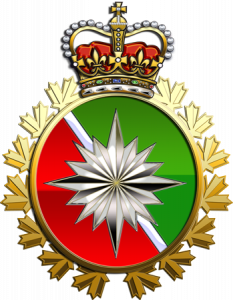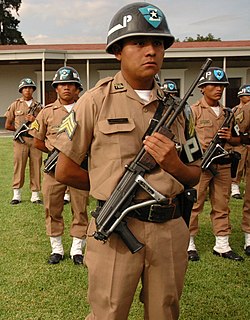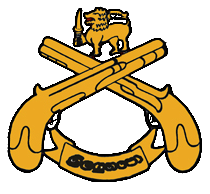
Military police (MP) are law enforcement agencies connected with, or part of, the military of a state.
The history of the Royal Canadian Air Force begins in 1920, when the air force was created as the Canadian Air Force (CAF). In 1924 the CAF was renamed the Royal Canadian Air Force (RCAF) when it was granted the royal title by King George V. The RCAF existed as an independent service until 1968. Prior attempts at forming an air force for Canada were the Canadian Aviation Corps that was attached to the Canadian Expeditionary Force, and a two-squadron Canadian Air Force that was attached to the Royal Air Force.
Canadian Forces Base Borden, formerly RCAF Station Borden, is a large Canadian Forces base located in Ontario. The historic birthplace of the Royal Canadian Air Force, CFB Borden is home to the largest training wing in the Canadian Armed Forces. The base is run by Canadian Forces Support Training Group (CFSTG) and reports to the Canadian Defence Academy (CDA) in Kingston.

The Royal Military Police (RMP) is the corps of the British Army responsible for the policing of army service personnel, and for providing a military police presence both in the UK and while service personnel are deployed overseas on operations and exercises. Members of the RMP are often known as 'Redcaps' because of the scarlet covers on their peaked caps and scarlet coloured berets.
Canadian Forces Station Debert was a Canadian Forces station located in Debert, Nova Scotia. It was most recently used during the Cold War as a communications facility and was home to a "Regional Emergency Government Headquarters" (REGH) complex, more commonly known by their nickname "Diefenbunker."

The Canadian Forces Military Police provide police, security and operational support services to the Canadian Armed Forces (CF) and the Department of National Defence (DND) worldwide.

The United States Air Force Security Forces (SF) are the ground combat force and military police service of the U.S. Air Force and U.S. Space Force. USAF Security Forces (SF) were formerly known as Military Police (MP), Air Police (AP), and Security Police (SP) at various points in its history. Due to its significant ground combat mission, Security Forces are often regarded as integral infantry within the Air Force and were formed on the premise of being the Air Force's "Marine Corps", in that they would provide security for the Air Force similar to how the Marines provide security for the Navy.
The Canadian Provost Corps was the military police corps of the Canadian Army. The Canadian Provost Corps was authorized on 15 June 1940. The Canadian Provost Corps was amalgamated with the police forces of the Royal Canadian Navy and Royal Canadian Air Force to become a new, unified branch of the Canadian Forces in 1968, known as the Canadian Armed Forces Security and Intelligence Branch.

St. John's International Airport is in Newfoundland and Labrador, Canada. It is located 3 nautical miles northwest of St. John's, Newfoundland and Labrador and serves the St. John's metropolitan area and the Avalon Peninsula. The airport is part of the National Airports System, and is operated by St. John's International Airport Authority Inc.

Canadian Forces Base Greenwood, or CFB Greenwood, is a Canadian Forces Base located 1.5 nautical miles east of Greenwood, Nova Scotia. It is primarily operated as an air force base by the Royal Canadian Air Force and is one of two bases in the country using the CP-140 Aurora and CP-140A Arcturus anti-submarine/maritime patrol and surveillance aircraft. Its primary RCAF lodger unit is 14 Wing, commonly referred to as 14 Wing Greenwood.

The Royal Cambodian Armed Forces is Cambodia's national military force. The Supreme Commander-in-Chief is King Norodom Sihamoni. Since 2018, General Vong Pisen has been the Commander-in-Chief of the RCAF as head of the Army, Navy, Air Force and the Gendarmerie. The armed forces operate under the jurisdiction of the Ministry of National Defence. Under the country's constitution, the RCAF is charged with protecting the sovereignty and territorial integrity of the Kingdom of Cambodia.
The uniforms of the Canadian Armed Forces are the official dress worn by members of Canada's military while on duty.
Canadian Forces Base Moose Jaw, also known as 15 Wing Moose Jaw, is a Canadian Forces base located 4 nautical miles south of Moose Jaw, Saskatchewan. It is operated as an air force base by the Royal Canadian Air Force (RCAF) and is home to RCAF Pilot training and 431 Squadron, the Snowbirds, which is the RCAF's air demonstration squadron.

The Intelligence Branch is a personnel branch of the Canadian Forces (CF) that is concerned with providing relevant and correct information to enable commanders to make decisions.

Provosts are military police whose duties are policing solely within the armed forces of a country, as opposed to gendarmerie duties in the civilian population. However, many countries use their gendarmerie for provost duties.

The Sri Lanka Corps of Military Police (SLCMP) is the branch of the Sri Lanka Army responsible for the policing of service personnel and providing a military police presence on service property, operations and exercises. It is made up of three regular regiments and with headquartered at Regiment Center Polhengoda, Colombo. Like other military police around the world, they continue to wear white webbing with barrack dress but white gaiters.

In the United Kingdom, the term military police refers to the three branches of the service police. Often, the term 'military police' is considered synonymous with the Army's Royal Military Police, but in fact, has a wider context. There are a number of civilian police forces whose role is to police other parts of the Defence Estate in the UK and overseas, but such forces are not correctly referred to as military police.

The unification of the Canadian Armed Forces took place on 1 February 1968, when the Royal Canadian Navy, Canadian Army, and Royal Canadian Air Force were merged to form the Canadian Armed Forces.
The history of army policing in Great Britain dates back to the middle ages. However, the predecessor units to the modern Royal Military Police were only formed in the 1870s and 1880s, merging in 1926 and being granted their 'Royal' prefix in 1946.
The Royal Canadian Air Force Band is a 35-member military band which represents the Royal Canadian Air Force in the Canadian Armed Forces. Currently located at Canadian Forces Base Winnipeg, the RCAF Band provides musical accompaniment for ceremonies of the RCAF in Canada. The band is presently under the command of Captain Chris Embree.












